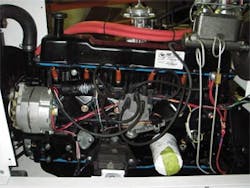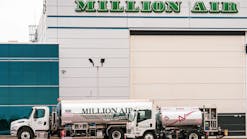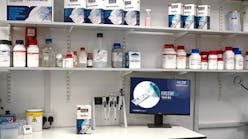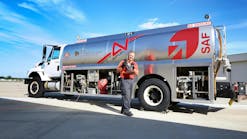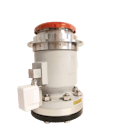By Joe Lewis
The use of both spark and compression-ignited engines at airports is nothing new. For as long as there’s been aircraft and airports, there’s been ground support equipment that uses these types of engines. For most of that time frame there has been little regulation from both local and federal authorities regarding the emissions these engines produce. While automotive engines faced increased scrutiny over fuel economy and exhaust emissions, their stationary and mobile off-road cousins conducted business as usual.
Today’s GSE manufacturers, airline fleet managers and airport administrators face pressure from several fronts simultaneously to lower emissions. Many states now enforce laws limiting emissions that are above and beyond those imposed by EPA. While engine manufacturers scramble to certify that their product will meet these requirements, existing fleets are now coming under the gun to clean things up as well.
In the previous article we discussed the use of hydrogen at the airport along with its benefits, sources and limitations. Aside from investing large sums of money to develop a localized hydrogen infrastructure, there are other alternatives that would allow the use of hydrogen on an individual or fleet-wide basis. The blending of hydrogen with traditional fuels such as diesel, gasoline, natural gas or propane is an effective means in which to lower emissions. Blending hydrogen with traditional fuels also paves the way for the future development of a full fledged hydrogen economy.
The blending of hydrogen with traditional fuels is not a new concept. The use of hydrogen with nearly any traditional carbon based fuel can improve combustion efficiency and lower emissions. Often, with minor adjustments most engines can be converted to use a hydrogen system in just a few hours. The question now is, where do we get that hydrogen from and what are the benefits of using it?
The blending of hydrogen into an engine’s fuel or air intake source can provide the fleet manager with several benefits. When introduced in small amounts (10 percent of fuel volume or less) to a diesel’s induction system, hydrogen will generally reduce smoke, hydrocarbon, nitrous-oxide emissions and particulate matter. Several researchers have additionally experienced moderate improvements in fuel efficiency. This author is presently conducting advanced research involving the use of hydrogen in diesel engines.
Hydrogen blending works especially well with gaseous fuels like propane and natural gas. In these applications the hydrogen can be proportionally mixed with the fuel before it enters the mixer. Minor adjustments in jetting would need to be made to make up for the difference in thermal density between the two gases. Presently, there are several successful examples of this type of hydrogen blending. In 2003, a California transit bus authority outfitted two buses with Cummins 5.9L engines fueled by a combination of 80 percent CNG and 20 percent hydrogen. Data collected since then has been very positive across the board. When compared with their diesel counterparts, these busses are miles ahead when it comes to emissions.
The following comparison shows the benefits of using blended hydrogen versus that of 100 percent CNG or Diesel. This data represents comparisons made between current production engines of the same size and type.
- 65 percent less NOx than diesel
- 50 percent less NOx than using CNG alone
- 80 percent less Particulate matter than diesel
- 10 tons less greenhouse gasses per year than diesel
- No loss in vehicle performance verses CNG alone
Presently, there are several companies that commercially specialize in the blending of hydrogen with natural gas for fleet operation. These companies traditionally strip the hydrogen from natural gas and then blend it with still more gas. The process consumes vast amounts of power and significantly increases the cost of the blended fuel. Once the fuel is blended, it is then stored under high-pressure storage tanks until needed.
Another way to more efficiently produce and blend hydrogen is to use an onboard electrolyzer. This process uses direct current produced by a high-output alternator and through the battery to operate an electrolyzer. The electrolyzer uses electrolysis to unbind water molecules into their base elements of hydrogen and oxygen. Until recently, electrolyzer efficiency has made this process impractical. HPW, a Houston based electrolyzer manufacturer is currently developing an advanced electrolyzer capable of producing all the hydrogen necessary to conduct onboard blending at ratios up to 50 percent. This electrolyzer will then be fitted into a piece of mobile ground support equipment using a 4.9L natural gas fueled engine.
Like any new technology, the electrolyzer concept will face hurdles. In order to apply this concept to past, present and future engines models, there must be an ability for the electrolyzer to interface with the engines control system. The ability to adjust hydrogen fuel volume based on engine RPM, load and environmental conditions is paramount to the future success of this system.
The use of hydrogen as the energy carrier of the future has already been predetermined. Presently, there exist federal and state incentives, for early adaptors to take advantage of, that are aimed at lowering the carbon footprint of everything from homes to cities. These early adaptors will reap the rewards of gained experience as well as their financial incentives.
Additional data regarding the use of hydrogen-blended fuel with ground support equipment will be published in the third quarter of this year.
